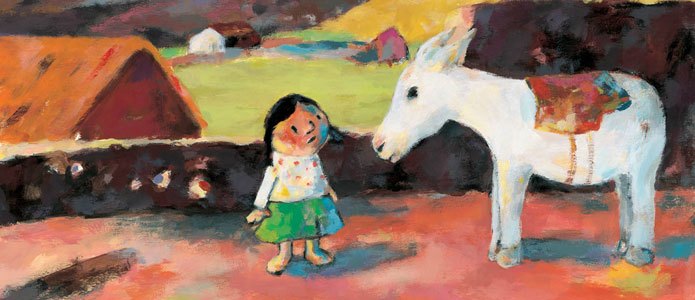The picture book author and illustrator Birte Müller finds a form of expression appropriate for children even for subjects such as death and life with Downs Syndrome. She is inspired by her travels and her son Willi.
The characters that romp through the children’s books of the illustrator Birte Müller are noisy and multi-faceted. There is, for instance, Fritz, the flatulent frog. Or Teddy, the living plush toy. Or the crazy figures in the picture book Wum und Bum und die Damen Ding Dong (Wum and Bum and the Ladies Ding Dong). “In my picture books I work very much like a painter. I never or hardly ever use line and drawing, and when I do, then mainly only as a brushstroke. For me, the mood, the atmosphere conveyed by painting is important”, says the Hamburg author and illustrator, describing her style.
Mourning: a subject for a children’s book
The graduate of the University of Applied Sciences in Hamburg illustrates not only the books of other authors, but has also created her own colourful universe. One of her characters is the Andean girl Felipa. She is the protagonist of the children’s book
Auf Wiedersehen Oma (Good-Bye, Grandma), in which the subject of mourning is treated in a manner oriented to children. Felipa’s grandmother has died. The little girl asks: Where is grandmother? How is she doing? Felipa sets off on a quest and learns that the souls of dead people live in their own world. And once a year, at the beginning of November, a huge festival is celebrated in their honour: the Día de Muertos, the Day of the Dead. On this Mexican holiday many people commemorate the departed.
From dissertation to children’s book
Müller developed the idea for this story during a study stay in Mexico, where she became acquainted with the death cult of the Día de Muertos. “The inclusion of death into the everyday life of people, the capacity for intense joy and melancholy, have always fascinated me”, she says. Out of this fascination arose initially not a children’s book but scholarly work. In an Andean village in Bolivia, Müller pursued the subject and wrote a PhD dissertation on it. It was only later that she developed the character of Felipa. “With this book, I would like to give families in Germany the opportunity to talk about death and bereavement, through the help of the distance provided by the setting in the foreign country of Bolivia”, explains Müller. People in many Western countries, she thinks, have lost the rituals surrounding death. “I believe this sometimes makes a society really poor – and it can actually even make the individual ill.”
For children with handicaps
An inspiration for Müller’s work has been her son Willi, who was born with Down syndrome. He was the model for the picture book
Planet Willi. In this book Müller’s style of illustration changes, with much sharper contours and many details. “This is because I designed the book for children who can’t speak well or not at all.” Pictures bear their own story, which can work without language. Müller also writes newspaper columns. Not always politically correct, but all the more honest for that, they are about the varied and crazy life of, in Müller’s own words, her “hyper-normal” family. Her latest book,
Wo ein Willi ist, ist auch ein Weg (Where There’s a Willi, There’s a Way), is also about the question of how a working mother masters everyday life with a handicapped son and an inexhaustibly creative daughter. The answer is simple: amazingly well.
